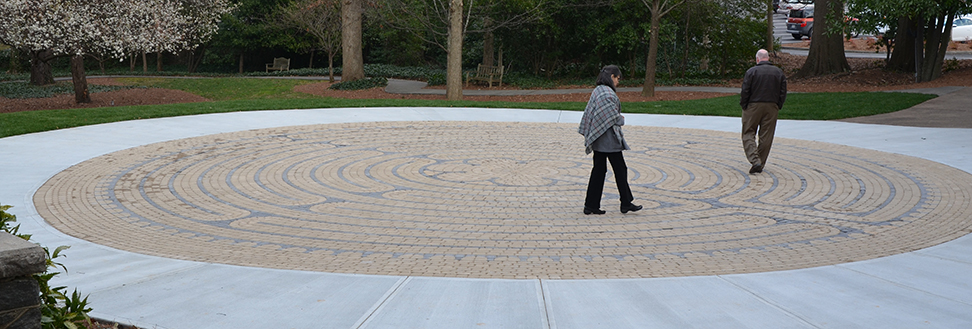The Cathedral Labyrinths
Thus says the Lord: Stand at the crossroads, and look, and ask for the ancient paths, where the good way lies; and walk in it, and find rest for your souls. – Jeremiah 6:16
 The Outdoor Labyrinth
The Outdoor Labyrinth
The outdoor labyrinth is located in the courtyard of the Lanier House on the Cathedral grounds. Labyrinths can be a place for prayer, meditation, and relaxation. In use for more than 3,500 years and on almost every continent, labyrinths are a physical path that allows people to explore their spiritual landscape. Labyrinths can also be a place for activity, fun, and chaos. As Dean Candler says, “All of these things are church.” The Cathedral Labyrinth is an accessible resource to deepen the spiritual needs of parishioners and visitors of St. Philip's. The labyrinth is a path to prayer to God that binds us to our spiritual ancestors and their pilgrimages through the ages.
The Design
 The Cathedral's outdoor labyrinth is modeled on the well-known design in the Cathedral of Notre Dame de Chartres in France. Built 800 years ago, the Chartres labyrinth measures thirty-nine feet in diameter and consists of eleven intricate circuits. The Cathedral's paver-based labyrinth is handicapped accessible. The area also is professionally landscaped with shrubs, benches, and lighting. In addition to the area's new use, it retains the ability to be used for picnics, St. Francis Day, and other Cathedral events.
The Cathedral's outdoor labyrinth is modeled on the well-known design in the Cathedral of Notre Dame de Chartres in France. Built 800 years ago, the Chartres labyrinth measures thirty-nine feet in diameter and consists of eleven intricate circuits. The Cathedral's paver-based labyrinth is handicapped accessible. The area also is professionally landscaped with shrubs, benches, and lighting. In addition to the area's new use, it retains the ability to be used for picnics, St. Francis Day, and other Cathedral events.
The Cathedral's outdoor labyrinth is open daily.
The Indoor Canvas Labyrinth
The Cathedral's canvas labyrinth is regularly available in Child Hall every Monday from 3 p.m. until 8 p.m., during the week days of Holy Week, and by special request. It is also available to other churches for a small rental fee. There is also a group called The Keepers of the Labyrinth that is committed to providing hospitality for this ministry. For more information contact Jeannie Mahood, 404-365-1031.
Walking the Labyrinth
The labyrinth provides us with a wonderful metaphor for pilgrimage. Medieval Cathedrals were often used in this way to symbolize a journey to the holy land. There has been a wonderful resurgence in interest in labyrinths as a way of praying in recent years. There is something very grounding and centering about slowing down and using movement to embody our prayer. Labyrinths and their patterns are ancient, predating Christianity. But, like many powerful symbols, they have been reinterpreted in a Christian context, like many of our church feasts and celebrations. They are found in many settings as places of quiet and reflection, such as hospitals and public spaces.
There is no right or wrong way to walk a labyrinth. The fewer expectations you bring to your walk, the more you can open to the leading of the spirit. People who walk labyrinths regularly as a part of their spiritual discipline, will tell you that they do not have the same experience every time. Like any prayer method, it is a structure that provides freedom for the Spirit to move and speak to where you are. It has one way in and one way out. If you think about the journey inward as a movement towards God, or the releasing of a burden, one can make your way with intentionality. Give yourself the time and space to discover your own pace as you walk to the center. If there are others walking at the same time, feel free to go around someone or pause as you might like. When you arrive at the center, this is a time of quiet reflection. It is a stop in the movement that allows you to absorb the invitation that your walking prayer was offering. Stay in the center until you feel an internal invitation to return. The path on the way out, while the same as the path in, now has been transformed to a different prayer. As you prepare to re-enter the world after pilgrimage, the walk outward gives you a chance to prepare to reengage the world and live into the prayers you have offered.
–The Rev. Canon Beth Knowlton, former Canon for Liturgy and Prayer
